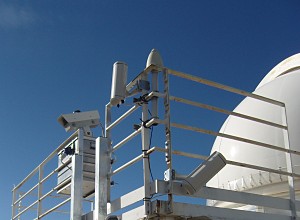| Observing stations |
 In
order to
obtain information about the atmospheric trajectory, orbit in the Solar System
and parent bodies of the meteoroids, meteors must be simultaneously recorded from
at least two observing stations. The meteor observing stations operated by Prof. Madiedo are located within a radius of about 100 km in the SW of
Spain. Most of the equipments are high-sensitivity video CCD devices that
automatically record meteor trails. A forward-scatter system and two low-scan
CCD cameras are also available.
In
order to
obtain information about the atmospheric trajectory, orbit in the Solar System
and parent bodies of the meteoroids, meteors must be simultaneously recorded from
at least two observing stations. The meteor observing stations operated by Prof. Madiedo are located within a radius of about 100 km in the SW of
Spain. Most of the equipments are high-sensitivity video CCD devices that
automatically record meteor trails. A forward-scatter system and two low-scan
CCD cameras are also available.
Two of the observing stations we employ are mobile systems that can be setup at any convenient place depending on the specific circumstances of the observing period. The remaining stations are robotic systems located at different observatories in Spain.
Although the first systems were setup in 2006 with the aim to detect meteors in the night sky, one year later Prof. Madiedo started to employ video CCD devices to detect bright fireballs in daylight conditions. Nowadays two of these stations separated by a distance of 70 km are covering the whole sky during the day.
Every observing stations monitors the night and day sky within a radius of about 500-600 km. In this way, these allow to cover about 95% of the Iberian Peninsula and some areas in the Mediterranean and the north of Africa.
 |
|
Location of the fixed meteor-observing stations operated by Prof. Madiedo. |
|
Web
design and programming: J.M. Madiedo
|